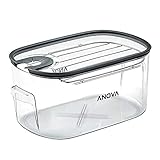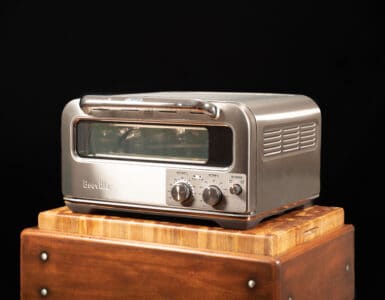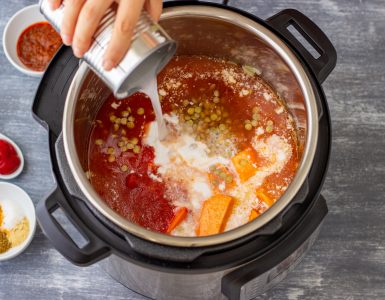This page may contain affiliate links. If you make a purchase through one of these links, we may earn a commission at no extra cost to you.
While you don’t need to buy a special container for sous vide to get started, having one will definitely make life easier once you’ve gotten serious about it. Unlike stock pots and coolers you may have kicking around, they tend to come with (or at least be compatible with) various sous vide accessories. Plus, having a designated sous vide container means that you don’t need to knock your biggest kitchen pot out of commission for hours or days.
The only question is, what sous vide container size do you need? In a perfect world, you could just get one container for any and every circumstance. But between the immersion circulators themselves, the containers, and whatever accessories you may want, you’re already looking at a huge storage commitment. And that’s before you even begin to branch out into multiple sizes!
You may live in a small space where storage is at a premium, or have a family of six to feed that just wouldn’t be able to manage with a small container. Whatever your use case is, there’s a container size (and compatible goodies!) to make your sous vide experience easy and enjoyable. So let’s talk size!
Table of Contents
Quick and Easy Answer: Which Sous Vide Container Size Should I Get?
We recommend you read the rest of the article to help you figure out exactly which size is best for you. But if you just want the quick and easy answers, here they are!
- Best for a single person in a small space who tends not to cook for others: 8-quart or 7-quart container. (We recommend the Lipavi Sous Vide Container Model C5! This purpose-built container is deeper than most of this size, so it works great.)
- Best for couples or a family of four if you don’t tend to host events: 12-quart container. (We recommend the EVERIE Sous Vide Container 12 Quarts with Lid and Rack! This is also our overall top pick for a container for most families.)
- Best for larger families or occasional dinner hosts: 16-quart to 20-quart container. (We recommend the Anova Culinary Sous Vide Cooker Cooking Container!)
- Best for frequent dinner hosts or very large families: 26-quart container. (We recommend the VÄESKE Large Sous Vide Container & Lid with Insulating Sleeve!)
Why Would I Want an 8-Quart or Smaller Container?
Bigger containers, like the many 12-quart options, are the usual standard. However, not everyone has the room to store them. If you’re a student in a dorm, live in a smaller, shared space, or even if you’re just single and don’t foresee cooking massive quantities or cuts, these smaller options may be just what you need.
There are plenty of options in both 7- and 8-quart sizes, but we recommend going as large as you comfortably can just in case you experiment with a dish that just barely wouldn’t make it with a smaller choice. You won’t be cooking a dinner for four or a rack of ribs, but there are certainly enough accessories to support you in cooking your solo indulgences in comfort.
Why Would I Want a 12-Quart Container?
12-quart containers are the man of the hour in the sous vide container world, and for good reason! They’re small enough to store easily, but big enough to be quite versatile for most uses. Single users who enjoy cooking some larger portions from time to time will find that they hold up to the task perfectly, easily handling both single portions and larger meals.
Couples can also make good use of the size to cook a shared meal all at once, making more time for each other as dinner cooks without much input from them once it’s going. Take turns wowing each other with special dinner nights or just keep meal time easy every night. And if you only want to cook certain parts of the meal in the container, they can work for a family of four as well. Sous vide your protein, then cook your carbs and veggies on the stove!
Those perks are fine enough, but since this is the most popular size of container for sous vide, you’re drowning in options for accessories as well. If your 12-quart container of choice doesn’t come with one already, we recommend picking up a rack to keep your food organized as it cooks.
Why Would I Want a 16- to 20-Quart Container?
Cooking for a family of four or more can be a big task, especially after a long day of work. Fortunately, containers of these sizes are more than capable of easing that burden, freeing you up from slaving over a hot stove. With some experience, you’ll be able to cook your proteins and sides in the sous vide bath at once—and a container of this size can handle all of that for a family of four.
We recommend a rack here, too, to keep everything tidy and easy to manage both in and out of the water. You may even consider weights as well. If you’re cooking lots of bags, their combined buoyancy may be enough to float some racks, so weights can be important at this size!
These larger containers are also a great size for diving into bigger, longer cooks (if you’ve got a lid that helps keep that heat in) that you just couldn’t manage in anything smaller.
Many people may never find that they need containers of this size, but those who do will be happy to note that the pickings are still plentiful for accessories in this range. The biggest consideration is the substantial footprint it’ll leave on your kitchen storage. Don’t make your kitchen storage and organization harder than necessary buying a container of this size if you’re never going to need all that extra room!
Why would I want a 26-Quart Container?
Things start to get a little expensive at this size, but these containers make up for it by being big enough to handle almost anything you can throw at them. You’ll have all the room you need to wow your guests at gatherings or cook massive cuts of meat to perfection with these “party size” offerings.
This size is perfect choice if you’ve recently discovered you’re hosting the holidays for the family, or just tend to be the go to host for get togethers of all sorts. Racks and weights are strongly encouraged, especially if you plan to fill one of these behemoths to capacity.
There is a small issue that begins to arise at this point, which is the reason we don’t recommend going even bigger. At this size you start to find less accessories, and the ones you do find are quite expensive. There are still enough to get you through, but going larger begins to tread into the territory of fashioning your own lids and racks. We typically prefer ease and simplicity, so we generally don’t recommend this unless it’s absolutely necessary for your next stroke of culinary genius.
What Kind of Container Do I Need?
Sous vide containers come in a couple of materials. The most common by a huge margin is polycarbonate or similar plastics. The issue that’s been associated with that from the dawn of time is whether or not it matters if the container is BPA free.
Our answer is “no.” Your food should be in BPA-free bags, and never directly touch the water in the container, meaning you don’t have to fret over the BPA content of the containers themselves (and most of them are not BPA free). There is some concern that BPA can leach into the bags over time, but we choose not to be too concerned about it.
There is a solution for those who definitely want to avoid BPA at all costs, though! You can either buy a metal sous vide container, or even just use an appropriately sized stock pot for your sous vide endeavors. It requires a bit more calculation and probably some handiwork on your part, but it’s definitely an option.
If you’re definitely wanting to go with metal but don’t already have a suitable pot (or don’t want to bother with figuring out a sous vide lid on your own), we recommend the EVERIE Stainless Steel 18/8 Sous Vide Container Pot. At 12 quarts, it’s the most common size for sous vide containers. Plus it doubles as a quality stock pot, and comes with a lid for both functions!
Are There Reasons Not to Use Things I Already Have at Home?
In most cases, not really! As we mentioned above, suitably sized stock pots are a fantastic option for the beginning sous vide enthusiast. Ziploc-brand bags are also just fine, and you can create an airtight seal without even needing a vacuum sealer!
There will probably come a time where you discover you could really have used that stock pot while it was busy circulating water, though, and that’s why we recommend picking up a dedicated container. Plus they’re generally inexpensive and open doors for increased ease and less stress.
It is, however, a bad idea to use some things. Coolers, for example, can be a poor choice because they just aren’t made to stand up to the prolonged heats of sous vide cooking and can become damaged. On top of that, it’s nearly impossible to find compatible accessories for them. In a lot of cases you won’t even be able to mount your immersion circulator without some handicraft.
On the subject, while some insist it’s perfectly possible, we also don’t recommend using the kitchen sink. There are just too many variables involved in what’s been put in there and when to consider it a particularly safe or sanitary vessel, not to mention the issues it shares with coolers.
It just isn’t worth the struggle to use either when there’s a thriving ecosystem of containers and accessories out there ready to make it so much easier.
Conclusion
Choosing the right sous vide container size for you is one of the most important steps in getting your ideal sous vide setup ready. There are only a few things to keep in mind at the end of the day: material, storage space, and cooking habits.
Once you’ve settled on whether you prefer a polycarbonate or metal container, consider how much storage space you have! You’ll already also need to store, at minimum, an immersion circulator and bags to seal your food in. You’ll also need to think about how many people you tend to cook for (just yourself? Large family gatherings?) to determine the right size for you. If all you cook at one time is a steak or two, don’t buy a massive, party-sized container that you’ll need to find a place for!
There are a ton of right answers and very few wrong ones, so don’t fret too much! Pick up a container that works for your needs and get started on your sous vide masterpieces. (After all, you can always add to your collection later!)















